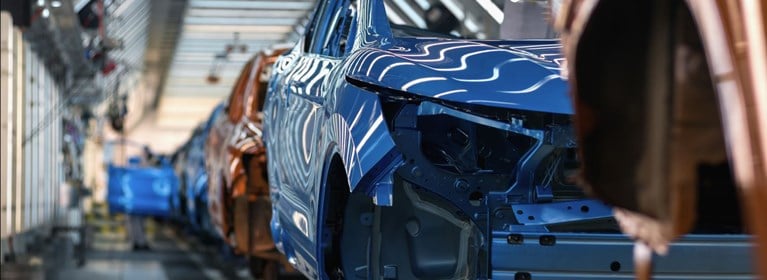Automated Bus Assembly Monorail System
Automotive Industry |
Power & Motion Technology |
By Magnetek |
Nov 14, 2011
Background
A North American bus manufacturer wanted to automate their new vehicle model assembly to increase productivity while maintaining high quality standards. In order to achieve the increased throughput that is required, the company decided to install two identical monorail systems. Each 3-carrier monorail system was designed to move vehicle parts from an assembly conveyor onto the vehicle body that is located on an on-ground conveyor system.
System Description
The hoist motion is controlled by an IMPULSE® P3 Series 2 drive, and the trolley motion on the the carrier is controlled by the V7 Yaskawa drive. The carrier operates manually around the monorail system through the use of an SBP2 10-button pendant station. The pendant station, which hangs underneath the carrier, controls all hoist and carrier motion. A carrier (tractor) tire is used to securely guide the carrier around the monorail. Carrier motion is not allowed until the tractor tire is fully engaged. Photoelectric sensors are used to position the carriers and to prevent carriers from running into each other.
System Operation
The carriers are queued at the beginning of the monorail system, waiting for the engine to chassis assembly process to begin. An operator begins the process by manually walking the empty carrier around to the loading position, which is located over the engine assembly conveyor. Once the engine is loaded onto the hoist, the operator manually moves the carrier over the on-ground conveyor system to unload the engine into the vehicle body.
During the assembly operation, the operator can initiate a “line speed” command which synchronizes the speed of the carrier to match that of the on-ground conveyor system, and automatically moves the carrier through the assembly process. This synchronization is achieved through the use of RF communication between the carrier and the on-ground conveyor system. Once the part has been installed into the vehicle body, the operator initiates a “return” command to automatically send the empty carrier back to the queue area.
If a return command has not been issued by the time the carrier reaches the end of the assembly line the carrier will stop and an alarm will sound to alert the operator. Once the return command has been issued, the alarm horn will stop and the carrier will automatically travel back to the queue area.
If another carrier is located within the pre-set distance parameters of the traveling carrier, the traveling carrier will slowdown and/or stop to avoid colliding with the carrier ahead of it.
Related Products
SBP2®
Pushbutton Stations
By: Magnetek
North America - EN





